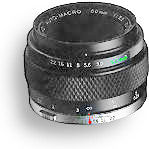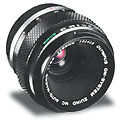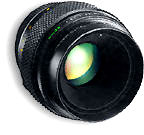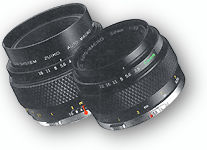Unlike macro lenses of 100 or 200mm focal length, 50mm Macro lens may give some inconveniences because you have to work in real close to achieve similar degree of magnification ratio - but on the other hand, this could also the only lens that acts both as a fine all rounder standard lens with extreme close focus capability. Noting all standard lenses can only close focus down to 0.45m where optical quality usually begins to deteriorate, the Zuiko lens is incorporated with a close range optical correction system where it will compensate by moving its rear elements to counter and correct aberrations commonly found on normal lenses when use in extreme close-up works.
Other than its close focusing
capability, the lens is also designed for shooting at conventional focusing distances.
An extra long Helicoid makes the tremendous focusing range of the 50mm Macro possible.
Use it as you would as any normal lens, focusing from 0.23 meter to infinity. The
ideal focal length is also very handy for copy work especially working with a copy
stand, it is a great and versatile lens for all kinds of function and application,
which is hard to match with any other standard lenses.
The Zuiko MACRO 50mm lens is a great lens which acts both as an lens for extreme
close-ups as well as a normal standard lens Macro lens while at the same time, maintaining
its extremely high optical performance across the entire focusing distance. This
lens has an extreme flatness of field and permits close focus ability all the way
from infinity to as close as 0.23m without any physical attachments while achieving
a 0.5X (1:2 reproduction ratio).
 |
Half life-size means it will fill the 35mm frame with a subject only 48mm x 72mm (1.92 x 2.88 in.) which is exactly half of a standard 35mm (36mm x 24mm) film format. |
By adding extension tubes or a bellows you can even focus close enough to shoot at 1:1 magnification or beyond. At 1:1 the image is life-size, that is, the size of the object on film is equal to the object's actual size.
The superb OM Microphotography group enables this remarkable close-up range extends up beyond 10X and followed by higher magnifications which can only be accomplished using a microscope and an adapter . The OM system is really the undisputed leader in specialized segment of macro photography
Regardless of whether you
are using a standard, long macro lens or using any form of extension to increase
reproduction ratio, there are a few things to note when working in close-up photography:
at close focusing distances depth of field is very shallow hence careful focusing
and minimizing camera movement is important. Magnifying the image also means magnifying
any errors in focusing or movement. The shorter the distance from the camera
to the subject, the shallower the depth of field and may demand more light reaching
the film and thus exposure compensation is required (The exposure reading will automatically
compensate that during the continuous metering process - but you may sense the shutter
speed indicator will drop significantly the closer it goes). Finding the exact point
of sharpness is essential (Depth
of field is always
greater in front rather than behind at the plane of sharpness). For those SLR bodies
that permits interchangeability of focusing screens, experiment if possible with
a variety of screens to find the one that works best for you. Generally, lenses with
smaller maximum aperture will transmit less light to the focusing mechanism which
in turns may cause darkening of the split image rangefinder of the focusing screen.
In such case, change to a plain type. Although NOT ALL OM SLRs have an interchangeable focusing screen
feature, you may refer to the OM Focusing
Screens section
to find more compatibility issues relate.
One way to assure accurate
focus is to stop down the lens as much as possible, taking advantage of the maximum
depth of field. However, as magnification increases the effective working aperture of the lens decreases. At f/5.6 and
1X magnification, for example, less light reaches the film than at normal shooting
distances; how much less is depended on magnification. Your SLR's through-the-lens
metering system should automatically compensates for this effective aperture change.
But you may have to use slow shutter
speeds for good
exposure. A tripod and cable release are invaluable aids in general close-up shooting
because hand-holding the camera at slow shutter speeds could easily leads to undesirable
camera movement.
The OM Zuiko optical system provides two very interesting options at this focal length with varying lens speed. A late inclusion is a relatively high speed Zuiko Macro 50mm f/2.0 and the classic Zuiko Macro 50mm f/3.5.
 |
Zuiko Macro 50mm F3.5 |
This remarkable macro offers reputedly high resolution from infinity to reproduction ratio of 1/2 life-size. It has an automatic close-focus correction mechanism which compensate and contain aberrations which is common for lenses working at extreme close distance.
The design has gone through few optical improvements since its inception. With the same angle of view as the standard 50mm lens, this lens offers the added advantage of normal angle of view as how we perceive things with a human vision. Although it is designed for optimum performance at 1/10 magnifications but its close focus optical correction also ensure its outstanding performance extends to close focus range. To achieve a life-size reproduction (1:1), just attach the lens with a 25mm Auto Extension Tube. To go beyond 1X, it is a handy lens to use with the Auto Bellow or the 65mm-116mm Telescopic Extension Tube. To go beyond 1X, check here for some OM solutions.
Specifications:
 |
Focal length: 50mm |
Angle of view: Diagonal:
46° Vertical: 27° Horizontal: 40°
Distance scale: (m) 0.23 to infinity (OO)
Focusing mechanism:
Helicoid
Magnification: 0.5X for lens used alone, 1X (1:1) with Auto Extension Tube 25mm
Minimum aperture:
f/22; Diaphragm: Automatic; Filter size: 49mm; Length: 40mm;
Weight: 200g (7.1oz); Recommended
Focusing Screens: 1:1*, 1:2*, 1:3*, 1:4*, 1:5#, 1:10*, 1:13*, 1:14* * Compatible.
Focusing and exposure accuracy remains. # Can be used,
they provide accurate focusing but exposure error may occur in manual mode for OM1 and OM2 series
models.
 |
Zuiko Macro 50mm F2.0 |
It incorporates a highly corrected optical formula and an exclusive close range focusing correction mechanism which maintains extremely high optical performance all the way from 1/10X magnification at infinity to 1:2 (Half Life Size) at its closest focusing distance.
You can also make use of the Auto Extension Tube 25mm to achieve 1:1 life size magnification and use OM Bellow and other means to go beyond that limit. The bright f2.0 maximum aperture provides a bright image finder for comfortable focusing; and the extra f-stop permits for more depth of field control over the f/3.5 version.
Specifications:
| Focal length: 50mm Aperture ratio: 1:2.0 |
 |
Magnification: 0.5X (1:2)
standalone; 1X (1:1) with Auto
Extension Tube 25mm Minimum aperture: f/16; Diaphragm: Automatic; Filter size: 55mm; Length: 55mm; Weight: 320g (11.3oz) <<<<<----- Size comparison between f/2.0 and f/3.5. |
Construction: 4 groups,
5 elements
Angle of view: Diagonal: 46° Vertical: 27° Horizontal: 40°
Distance scale: (m) 0.24 (0.8ft) to infinity (OO)
Focusing mechanism: Helicoid
Recommended Focusing Screens: 1:1*, 1:2*, 1:3*, 1:4*, 1:4n*, 1:5#, 1:6#,1:10*, 1:13*, 1:14* * Compatible. Focusing and exposure accuracy remains. # Can be used, they provide accurate focusing but exposure error may occur in manual mode for OM1 and OM2 series models.
| Previous | Back
| 3/3
to Index Page of Zuiko
50mm lenses
Relative: OM Micro lenses at 20mm and 38mm
| Back | Index Page of OM Zuiko Lenses
|
Back | to Main Index Page of OM1(n) &
OM2(n) Series SLRs
| Message Board | for your favourite Olympus
OM-1(n)
and OM-2(n)
series
SLR Camera models
| Message
Board
| for your Zuiko
Optics in a shared environment
| Message Board |Specifically
for Dispose or Looking for OM Photographic
Equipment
Home - Photography in Malaysia |
Copyright
© 2000.
leofoo ®. MIR Web Development Team.
My old
time buddy, Ahmad
Ikram,
Dr of Rubber Research Institute (RRI), Malaysia who
shares the same passion with me and also left his collection of OM-1n, OM-4 bodies
alsong with a Motor Drive 1 preparing some images appeared in this site. Mr Poon
of Foto Poon, Ipoh, Mr Richard, Ampang Park, Mr Lim and Miss
Jenny of Foto Edar for their generosity for their OM1(n), OM2n camera and some
Zuiko lenses. Mr KKLow for some of his earlier images on the OM-1. Miss Wati and Mirza for helping me to convert this
Operation Manual into a HTML format. Mr MCLau for rectifying some mistakes
made on the earlier preview sites. Site created 'unfortunately' again with a PowerMac
A
personal tribute to the creator of the OM system and also a site dedicated to all
the fans of Olympuses and Zuiko Optics worldwide. Olympus is a registered tradename of Olympus
Inc, Japan.